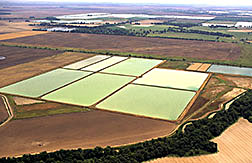Oceanographic Instruments Monitor Fishpond Algae
 Catfish ponds showing algae growth. (K4724-13) |
Carl Jeffers manages Top Cat Fishery in Portland, Arkansas, a fast-growing company that sells 400,000 pounds of catfish weekly. The Catfish Farmers of America named him Arkansas' Catfish Farmer of Year for 1995. But he wants to do more.
"If we could find an economical way to control off-flavors and the blue-green algae that produce them, it would be a tremendous boon to the industry, no question," he says.
Many producers would agree. Currently, a major obstacle to catfish sales is the off-flavor compounds produced by microscopic algae. These natural algae by-products are absorbed into the fishes' meat, giving them a muddy taste. The fish are still safe to eat, but they just don't taste good anymore.
It's estimated that during the late summer and fall, as much as 80 percent of U.S. catfish loses some flavor quality.
As a result, many are unmarketable, causing an extra $5.8 to $12 million in overhead costs. That's why three times a week, Jeffers takes fish from harvest-ready ponds for flavor testing by processors.
Catfish ponds are an ideal habitat for algae, which are often beneficial to the farmer. They provide oxygen for the fish and help stabilize pond temperatures. But it's not possible to predict when the algae will produce the off-flavor compounds.
Recently, Agricultural Research Service scientists David F. Millie and Chris P. Dionigi joined forces with Oscar M. Schofield, a professor of oceanography at Rutgers University, to develop ways to monitor algae in catfish ponds.
The studies focus on the relationship between the algae present, their health, and the presence of off-flavors.
In a series of experiments at Stoneville, Mississippi, the research team explored using oceanographic instruments to see if they might provide an efficient means to monitor algae in catfish ponds. These instruments, which measure the optical properties of water, might be used to estimate how much and what kinds of algae are present in a pond.
Algae require light for growth. But some absorbed light is re-emitted as fluorescence in a process that can provide basic biological information about algae cells.
Researchers are looking at an instrument called the SAfire (Spectral Absorption and Fluorescence Instrument), which can measure the color of light that algae fluoresce. Scientists have long speculated this information could be used to assess the kinds of algae in a pond—particularly the blue-green algae associated with off-flavors. A second instrument, the pulse amplitude modulated fluorometer, measures how much light is fluoresced by algae cells, which allows researchers to estimate how healthy the algae are.
"What we hope to do is differentiate algae by their fluorescence properties and determine whether there is a connection between algae health and the production of off-flavor compounds," says Millie, a microbiologist at ARS' Southern Regional Research Center in New Orleans, Louisiana.
"While initial results were promising, we need to finish analyzing all the results," says Millie's colleague, plant physiologist Dionigi. "The instruments were designed for clear, blue ocean water and might not provide reliable information in murky catfish ponds."--By Jill Lee, ARS.
USDA ARS Food and Feed Processing Research Unit, Southern Regional Research Center, P.O. Box 19687, New Orleans, LA 70179; phone (504) 286-4457.
"Oceanographic Instruments Monitor Fishpond Algae" was published in the November 1996 issue of Agricultural Research magazine.






